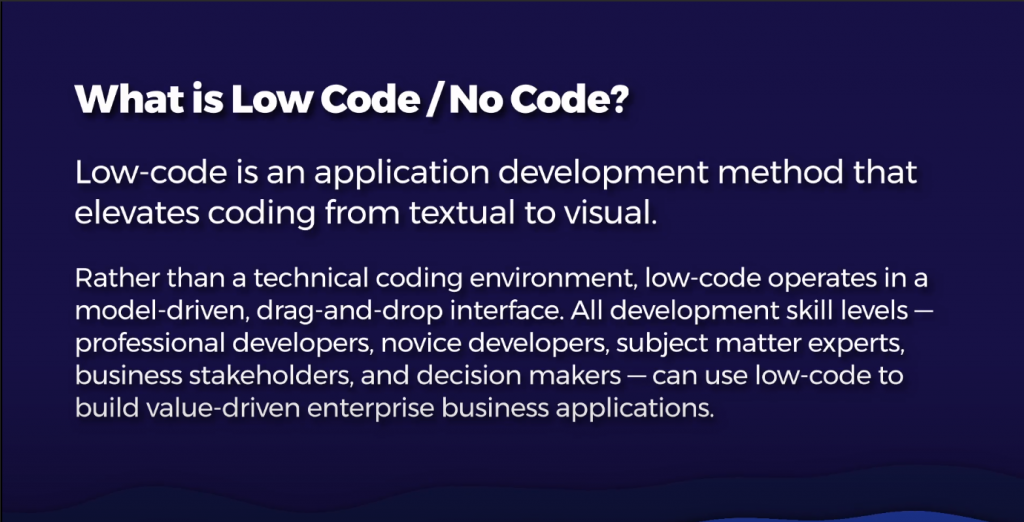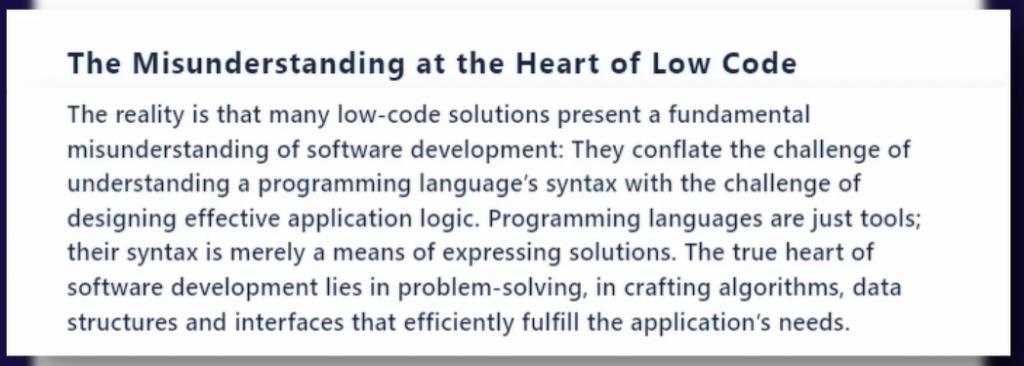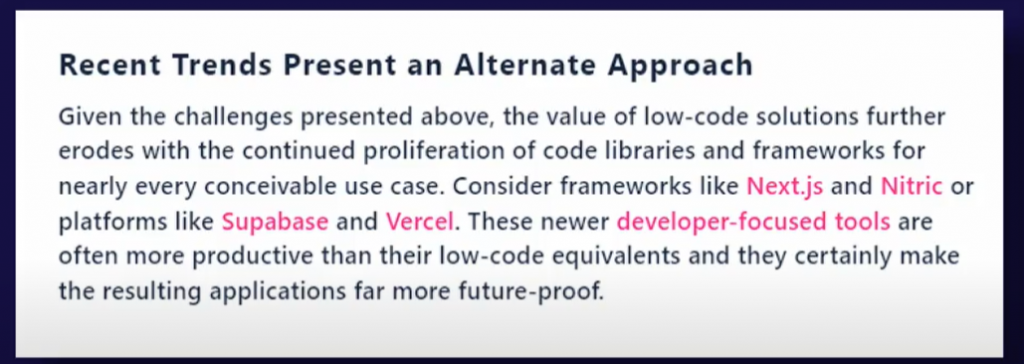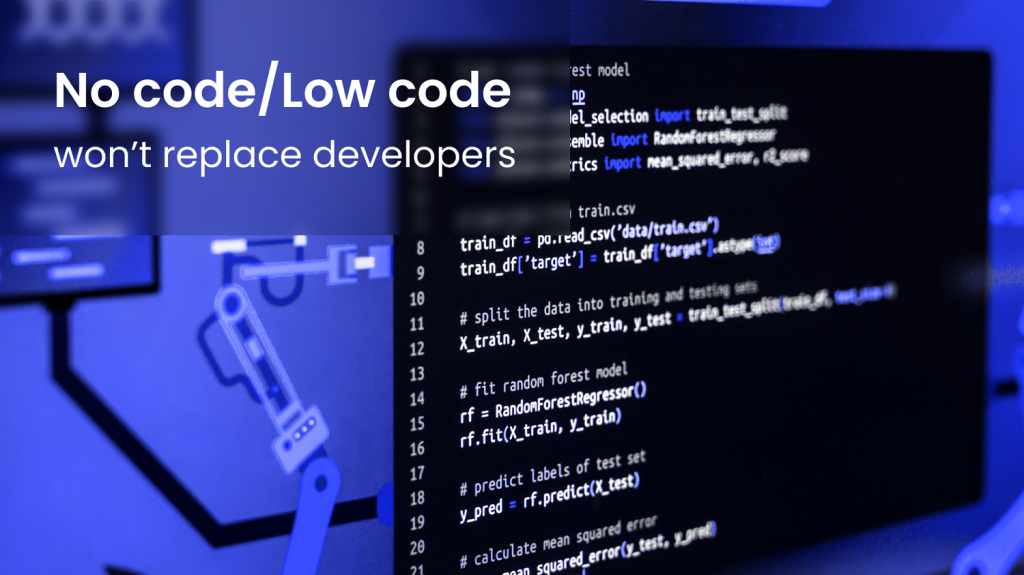Did the no code/low code campaign miss or hit the mark?
Here’s what I think: it hit a different area from what it was originally intended. It serves its purpose, but it will work better if it targets the right kind of people. Let’s dig right into this.
What is No Code/Low Code?
Here’s a quick definition for no code/low code:

To summarize the above, the goal of no code/low code is to make what’s called a “citizen developer.”
What does this mean? It means that rather than going to your IT department to get something coded, you empower your entire organisation to write their technology pieces. This makes sense on paper since they’re the ones who know the problem.
At least that was the intent of no code/low code. But has it done that? Or, like I said above, did it solve a different problem?
Some Examples of No Code/Low Code
Before I answer that, let’s look at some examples of what no code/low code can do. Here are a couple of examples from Zapier, which is a popular no-code platform.

The first one is the sharing of Google Forms responses in a Slack channel. If a Google Form has got a response, it will connect to Slack and send a message to a predetermined channel.
That doesn’t sound too much at first. But when you’re running a survey and getting responses, people will watch the Slack channel more than they’ll watch the Google Form that sits behind it. This allows them to trigger relevant actions faster based on the responses they get.
Here’s another simple example:

This one’s great for business owners who don’t want to log into Xero every day or week but are always on their emails. This no-code solution gives them a summary of their sales figures and similar data straight from their inbox.
Instead of going to a developer to write a report, you can simply hook together your email, Zapier, and Xero.
No Code/Low Code vs High-Code (Traditional) Development

Building software is complex; it’s difficult and takes a long time, plus there’s a limited amount of talent. You have to fix business problems through technology. So what no code/low code tries to do is to bring back technology into the hands of the business people. That way, they can create their tools.
It sounds so simple and straightforward… but things haven’t quite worked out that way.
The Heart of No Code/Low Code
I’ve come across an article that excellently summarizes the heart of the no code/low code situation. It reads:

It continues:

And here’s what I think:
Software programming — the art of writing code — is a tool. It’s similar to a shovel, a rake, or an excavator —- all of these move dirt, but they’re operated differently.
The same applies to software programming. It’s how you operate the tools you have and how you solve problems. That’s all that matters in programming.
Programming is a mindset. It’s how you look at a problem and break it down into smaller sections. It’s how to turn it into an algorithm with repeatable steps to achieve a goal.
And with algorithms, you must have clear steps. If A happens, then B happens. Otherwise, C happens. You fork that all the way until you solve a business problem.
Programmers work out solutions that way and that solution can be written in any language.
Remember: the programming language is just a tool. It all boils down to the thought process — that’s the important part.
And no code/low code doesn’t get around this. It still exists at its heart.
That’s why these “citizen developers” struggle.
True: the Google Form and Slack no code integration is easy. But what happens when you need to add some more scenarios? What if you want to send a specific email based on a certain answer?
You’ll have to map out all flows and do problem-solving programming. And that’s where no code/low code tools fold out.
Coding Syntax
No code/low code development was created to fix the developer syntax issue. Let’s circle back to the earlier article and see more:

More and more libraries are coming to the market. This makes actual syntax less and less important. That’s because they’re pushing coding closer to the user and the public.
At Flying Donkey, we use some no code/low code platforms to plug gaps in easy-to-solve problems.
Once the thinking has been done and we’ve worked out our criteria, we use such platforms to plug gaps, such as sending emails or connecting to APIs. These tasks are great for no code/low code platforms.
On the flip side, we do custom development for parts or use more complex cases. That way, we get the best of both worlds.
Remember, the citizen developers — which may be an SME or a business owner — isn’t the one in the driver’s seat. It’s the developer who’s using the tool and helping them expedite their workflow.
No Code/Low Code Platform’s Place in Development
The main point I want to get into is this: no code/low code platforms have their place in the development world.

The problem is: they’re targeting the wrong audience. They try to target SMEs and end users — when the real problem is the problem-solving aspect of development.
It’s the programmers who have these problem-solving skills, and if you equip them with better tools, they’re going to solve problems faster.
Take a hybrid approach. This isn’t an all-or-nothing choice. No code/low code won’t replace developers, and developers will start using such tools alongside their existing ones. They’ll develop solutions better and faster as they move away from cookie-cutter code.
So, Did It Hit The Mark?
Technically, no code/low code platforms hit their mark. They tried to make a vast army of citizen developers, but they found their mark by helping developers and adding another toolkit to their arsenal.
And real issue no code/low code needs to solve isn’t the syntax; it’s about turning business problems into program solutions, and SMEs and non-programmers struggle with this. By putting the no code/low code solutions in the hands of developers, you’ll expedite their product delivery, bringing your products to market faster.

No code/low code is here to stay, and we’re using them extensively at Flying Donkey. We’ve also helped clients implement such solutions in their practice.
If you need more no code/low code solutions in your business, or you’re trying to get products to market faster, feel free to reach out to us — we’re always happy to help!




